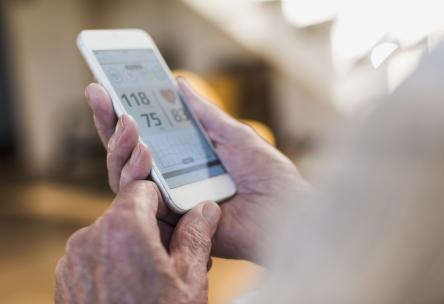Keep tabs on your health and instantly share the results with your doc—no appointment required

With a smartphone, it’s easy to keep track of your relatives’ lives, the weather, the news, and your email.
Now, you can go ahead and add your overall health to that list of items.
From blood pressure to blood sugar, many of these apps and portable electronic devices can help you keep an eye on important vital signs and metrics. In some instances, this data can be sent directly to your doctor.
But are they right for you? Here are a few self-monitoring advancements to discuss with your doctor.
Blood Pressure
The Omron HeartGuide watch allows wearers to share blood pressure readings with their doctor in real time, using the HeartAdvisor app. Like arm cuffs and larger wrist-worn devices, it works by inflating intermittently, using the same tech that's in Omron’s hospital-grade monitors.
Blood Sugar
In 2017, the FDA approved the first blood sugar monitor that doesn’t require a blood sample: Abbott’s FreeStyle Libre Flash Glucose Monitoring system. The wearer places a sensor patch on their upper arm, and then whenever a self-check is needed, they wave a small handheld scanner over the patch. The scanner records the blood sugar level, calculates any trends from the last eight hours, and predicts whether sugars will rise or fall in the near future. Other researchers are working on wrist-worn devices with similar tech, as well as contact lenses to measure the glucose levels in tears.
Body Composition
The Skulpt Scanner is a smartphone-size device that works with the Skulpt app to measure, track, and analyze body fat percentage and muscle quality. As a bonus, users can plug in personal goals and receive workout advice, including guidance from a panel of trainers. In one study published in Geriatrics, the older adults who used the device needed very little training before they were able to conduct self-checks––and with reliable results.
Atrial Fibrillation (A-Fib)
Recently, researchers from Stanford, in an Apple Heart Study of more than 400,000 people, found that both the Apple Watch (series 1, 2, or 3) and iPhone can help detect atrial fibrillation (or A-Fib), which can increase the risk of heart failure or stroke. When the watch alerted the wearer of an irregular pulse, 84 percent of the time he or she was found to be in A-Fib. Since this is a condition that often shows no symptoms—and comes and goes—constant monitoring is important.
On the Horizon: High-Tech Toilet Seats?
The Rochester Institute of Technology recently developed a toilet seat that can monitor heart rate, blood pressure, blood oxygenation levels, weight, and other metrics. This device is now going through the FDA clearance process. Hopefully, it will prevent readmissions for patients who were hospitalized due to heart failure.
The bottom line: To ensure you’re getting a safe, reliable, and effective product, seek guidance from a reputable medical professional or resource. The U.S. Food and Drug Administration has a searchable database of products including medical devices. You can also ask for suggestions from your doctor, pharmacist, or another person on your health care team, such as a diabetes educator. These experts can help you learn how to use the device properly, tell you what results to look for, and explain what to do about the numbers on the readout.

